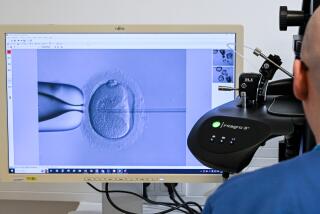It’s Kramer vs. Kramer vs. Somebody Else : Guidance from Legislature needed on surrogate issue
- Share via
The breakup of a family is the underlying tragedy running through all the dramatic developments in Moschetta vs. Moschetta and Jordan.
This is an unusual case where a judge has granted legal rights, though not custody, to a surrogate mother, as the sponsoring couple are divorcing.
It is the latest twist in California’s surrogacy circus. While the debate in California over surrogacy agreements has been advanced to the point where a surrogate now has standing in a custody battle, little new light has been shed on the lingering question of whether surrogate motherhood should be legal and, if so, how it should be regulated. Those issues must be resolved soon.
Elvira Jordan, a surrogate who is the biological and genetic mother of a 10-month-old child, had wanted to help an infertile Orange County couple, Robert and Cynthia Moschetta, know the joys of parenthood. But the demise of the Moschettas’ relationship began to undermine the wonderful possibilities that science had made available to them. The judge took note of Jordan’s concern for the baby and the state of the Moschettas’ marriage, and now the surrogate says she will seek primary custody.
The derailing of the best intentions of couples or surrogates is the common thread in this case and in another case--the lawsuit brought by surrogate Anna M. Johnson--that raised quite different issues. Surrogate cases, including the well-known Baby M case in New Jersey, show again and again that the opportunities opened by reproductive technology are not immune from changes of heart on any side of an agreement. In California, all of these complexities point to an urgent need for better guidance from the Legislature.
In deciding who had legal standing as the baby’s mother in the Jordan case, Orange County Superior Court Judge Nancy Wieben Stock simply cleared the way to make this essentially a custody battle between biological parents, with an estranged wife left to watch on the sidelines. Now the court can try to sort out what it would do in any custody case--that is, attend to the parental issues left unresolved when two people cannot resolve their differences within a marriage. These are different circumstances indeed from the Johnson case, where the sponsoring couple’s marriage was intact, where the surrogate was not the genetic mother and where a contract ended up being central to the decision.
In the Jordan case, the judge was able to treat the issue as a custody fight rather than a contractual dispute because, to her apparent relief, none of the attorneys had insisted that the surrogacy contract be enforced. The way was thus cleared for this case to make its special contribution to the debate in California, namely, that the claims of the surrogate could be elevated in status by her designation as a legal parent.
But while turning Moschetta vs. Moschetta and Jordan into a custody case may afford the best avenue for resolving this dispute, it also inevitably increases the number of dissatisfied parties. We now have Kramer vs. Kramer and somebody else; the courts are left with a new wrinkle in a custody fight.
And Cynthia Moschetta gets a double whammy. For all of her efforts to overcome the anguish of infertility, she got more pain in the end--disqualification from the playing field in the custody fight that is now shaping up. She was found to have no claim at all because she had no biological tie to the child. Yet she helped arrange and pay for the birth and took maternity leave to care for the child.
Difficult as it was to reduce all of these complex issues to somewhat manageable terms, the case might have been even more difficult had lawyers not agreed that the contract was unenforceable. All the more reason for the Legislature to come to terms with these difficult issues in surrogacy agreements.
More to Read
Sign up for Essential California
The most important California stories and recommendations in your inbox every morning.
You may occasionally receive promotional content from the Los Angeles Times.










